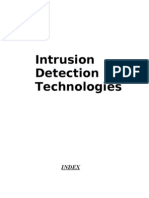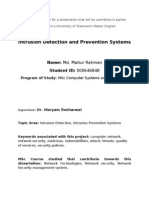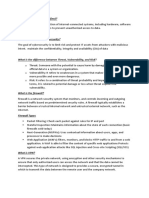A Java Based Network Intrusion Detection System (IDS)
Uploaded by
Prasanth ReddyA Java Based Network Intrusion Detection System (IDS)
Uploaded by
Prasanth ReddySession ENG 206-118
A Java Based Network Intrusion Detection System (IDS)
Allam Appa Rao, P.Srinivas, B. Chakravarthy, K.Marx, and P. Kiran
Department of Computer Science and Systems Engineering,
Andhra University College of Engineering, India
allamapparao@gmail.com
Abstract
The number of hacking and intrusion incidents is increasing alarmingly each year as new
technology rolls out. Unfortunately in today’s digitally connected world, there is no place to
hide. DNS, NSlookup, Newsgroups, web site trawling, e-mail properties etc. are just some of
the many ways in which you can be found. In this research project, we designed and build an
Intrusion Detection System (IDS) that implements pre-defined algorithms for identifying the
attacks over a network. The Java programming language is used to develop the system, JPCap
must be used to provide access to the winpcap. The packets in the network are captured online
i.e., as they come on the interface of the network. The IDS is designed to provide the basic
detection techniques so as to secure the systems present in the networks that are directly or
indirectly connected to the Internet.
I. Introduction
An intrusion is somebody (“hacker" or "cracker") attempting to break into or misuse your
system. The word "misuse" is broad, and can reflect something severe as stealing confidential
data to something minor such as misusing your email system for spam (though for many of us,
that is a major issue!). With the emergence of Internet and the World Wide Web, the concept of
Global village has taken its inception. There are facilities to virtually achieve any kind of
information on the internet. All these advantages have been achieved because of networking
computers and associated devices. There has been a rapid progress in this field. Along with this,
there is the arms race between the intruders and people who provide security to the systems in
networks. This project IDS (detection and protection) [2, 3] runs on the host machines and
assists the network Administrators to detect several intrusion attacks and inform to the owner of
the system and also provide security by blocking the malicious users based on their IP
addresses.
Network Intrusion:
A deliberate attempt to enter a network and break the security of the network and thus breaking
the confidentiality of the information present in the systems of the network. The person who
tries to attempt such an action is called as an Intruder and the action can be termed as Network
Proceedings of The 2006 IJME - INTERTECH Conference
Intrusion. The network administrator is supposed to protect his network from such persons and
this software can help his in his efforts.
Intrusion detection systems (IDS)
An Intrusion Detection System (IDS) is a system that is responsible for detecting anomalous,
inappropriate, or other data that may be considered unauthorized occurring on a network. An
IDS captures and inspects all traffic, regardless of whether it’s permitted or not. Based on the
contents, at either the IP or application level, an alert is generated.
Need for an IDS:
Intrusion detection devices are an integral part of any network. The internet is constantly
evolving, and new vulnerabilities and exploits are found regularly. They provide an additional
level of protection to detect the presence of an intruder, and help to provide accountability for
the attacker’s action.
Four different types of attacks have been identified which makes the need for an IDS critical.
Denial of service
Network-based denial-of-service [1, 2, 3] attacks are one of the easiest types of attacks. It often
requires little effort to fully consume resources on the target computer, to starve the target
computer of resources, or to cause critical services to fail or malfunction. Internal corporate
networks typically do not have internal filtering defenses against common denial-of-service
attacks, such as flooding.
Threat to Confidentiality
Some viruses attach themselves to existing files on the system they infect and they send the
infected files to others. This can result in confidential [1] information being distributed without
the author’s permission.
Modification of contents
Intruders might be able to modify news sites, produce bogus press releases, and conduct other
activities, all of which could have economic impact.
Masquerade
A masquerade [1, 2, 3] takes place when one entity pretends to be a different entity.
Authentication sequences can be captured and replayed after a valid authentication sequence
has taken place, thus enabling an authorized entity with few privileges to obtain extra privileges
by impersonating an entity that has those privileges.
Any system connected to the internet and providing TCP-based network services (such as a
Web server, FTP server, or mail server) is potentially subject to this attack. Note that in addition
to attacks launched at specific hosts, these attacks could also be launched against your routers or
other network server systems if these hosts enable (or turn on) other TCP services (e.g., echo).
Proceedings of The 2006 IJME – INTERTECH Conference
The consequences of the attack may vary depending on the system; however, the attack itself is
fundamental to the TCP protocol used by all systems.
II. Requirements For IDS
The requirements to develop the system or software can be listed at two levels of abstraction.
High Level Requirements:
• To develop an application that is capable of sniffing the traffic, to and from the host
machine.
• To develop an application that is capable of analyzing the network traffic and detects
several pre-defined intrusion attacks and mappings.
• To develop an application that warns the owner of the host machine, about the possible
occurrence of an intrusion attack and provides information regarding that attack.
• To develop an application that is capable of blocking traffic to and from a machine that
is identified to be potentially malicious and that is specified by the owner of the host
machine.
Low Level Requirements:
• To develop an application capable of displaying the traffic to and from the host machine
in the form of packets to the owner of the host.
• To develop an application capable of detecting occurrence of Denial of Service attacks
such as Smurf Attack and Syn-Flood Attack.
• To develop an application capable of detecting attempts to map the network of the host,
using techniques such as Efficient Mapping and Cerebral Mapping.
• To develop an application capable of detecting activities which attempt to gain
unauthorized access to the services provided by the host machine using techniques such
as Port Scanning.
• To develop an application that maintains a “Log Record” of identified intrusion attacks
done on the host in the present session and also displays it upon request.
• To develop an application that displays the list the active and inactive methods of which
each scans for a specific intrusion attack.
• To provide options to activate or de-activate each of the Attack Detection methods.
• To provide an option to the user of the host to frame Rules which explicitly specify the
set of IP addresses that are to be blocked or allowed. These Rules determine the flow of
traffic at the host.
III. Purpose And Scope
Purpose of the system: The purpose of the system is to detect certain well-known intrusion
attacks on the host system and display warnings to the user and also store information regarding
the IP addresses and allow the traffic based on that information.
Scope of the system: The system frames certain rules based upon the input given by the user. It
then allows traffic inwards or outwards based upon the rules. The system also detects certain
well-known attacks and gives warnings to the user.
Proceedings of The 2006 IJME – INTERTECH Conference
System overview
When packets arrive at the system, they are sniffed by the sniffer and then various processing
techniques are applied to detect if any attack is being done, in which case a warning is given to
the user.The attacks detected are predefined and well known. In this system the following
attacks detection are implemented.
• Port Scanner,
• Smurf Attack,
• SYN Flood Attack,
• Efficient Mapping, and
• Cerebral Mapping.
The system has also provision to block traffic from a specific IP address which may have been
recognized to be malicious or troublesome. There is also provision to allow traffic from specific
IP addresses for some trusted systems, from which traffic is not monitored. Traffic from
unknown hosts is monitored and any potential attacks are informed to the user.
System structuring
The Architectural Design is depicted as a block diagram where each box in the diagram
represents a sub-system. The arrows indicate data or control flow in the direction specified by
them. The Architectural block diagram presents an overview of the system architecture (Figure
1).
Figure 1. Architectural diagram showing overview
Internet/Intranet
Operating System
Sniffer Protection Unit
Intrusion Units Control Unit Store
Console Owner-GUI
Proceedings of The 2006 IJME – INTERTECH Conference
Description
The above diagram is the structural model of architecture for the present system.
In this system, the Sniffer sub-system captures the packets which flow into and out of the
system. This sub-system then formats these packets in a format that is convenient for further
processing. Jpcap is a part of this Sniffer sub-system .The packet capturing function is
accomplished via Jpcap. It provides a Java API to the popular C packet capture library called
pcap. While Jpcap is not a complete conversion of the popular C pcap library yet, it does
provide the basic functionality we need. There are various Intrusion units each for a specific
attack. So, there are individual intrusion units which detect Port Scanning, Smurf Attack, syn-
flood Attack, Efficient Mapping and Cerebral Mapping. All these intrusion units are
independent of each other and interact only with the Control Unit. They run simultaneously
continuously scanning for occurrence of specific attacks and report the attacks to the Control
Unit when detected. The Store sub-system stores the various Rules defined and given to it by
the Control Unit. It consists of various other sub-systems for data processing. The data in the
form of XML files is stored after encryption using Simplified DES algorithm. The Owner-GUI
sub-system displays to the user the defined Rules, the attack logs and the running status of the
Intrusion units. It also provides facilities for starting and stopping intrusion units, clearing
attack logs, adding new Rule to the store and deleting existing Rule from the store.
The console sub-system performs functions similar to the Owner-GUI sub-unit, but displays at
the command line. The Control Unit sub-system manages the sub-systems for detection of
attacks by taking the packets from the sniffer, sending relevant packets to the Intrusion Units,
gives Rules to the store and retrieves them and displays necessary messages to the user through
the user interface. The Protection Unit sub-system takes the Rules from the Control unit and
provides security by applying the rules on local Operating System as IPSec policies.
Detailed Class Descriptions:
There system contains a total of 31 classes where 7 of them are inner classes.
The following are the important classes identified,
PacketCapture,
IntrusionAttacks,
IntrusionUnit,
Attack,
Rule,
ProtectionUnit,
SimpleDES,
XmlData,
DataProcessor,
ControlUnit,
Console,
Owner, and
IDSMain.
Proceedings of The 2006 IJME – INTERTECH Conference
UML Diagram showing PacketCapture
java.lang.Thread
ids.PacketCapture
jpcap: jpcap.Jpcap
jh: jpcap.JpcapHandler
+run(): void
UML Diagram showing IntrusionAttacks
ids.IntrusionAttacks
+portScanner(java.io.ObjectInputStream ois,java.ioObjectOutputStream output):void
+smurfAttack(java.io.ObjectInputStream ois,java.io.ObjectOutputStream output): void
+synFloodAttack(java.io.ObjectInputStream ois,java.io.ObjectOutputStream output): void
+efficientMapper(java.io.ObjectInputStream ois,java.io.ObjectOutputStream output): void
+cerebralMapper(java.io.ObjectInputStream ois,java.io.ObjectOutputStream output): void
XmlData showing various tags
ids.XmlData
+XmlData(java.lang.String xmlFile)
+writeDecryptedFile(java.lang.String source, java.lang.String dest): void
+writeEncryptedFile(java.lang.String source, java.lang.String dest): void
+addSingleIP(java.lang.String ip, java.lang.String status): void
+removeSingleIP(java.lang.String IP): void
+addRangeIP(java.lang.String ipstart, java.lang.String ipend, java.lang.String status):void
+removeRangeIP(java.lang.String ipstart, java.lang.String ipend): void
+addSubnetIP(java.lang.String ip, java.lang.String mask, java.lang.String status): void
+removeSubnetIP(java.lang.String ip, java.lang.String mask): void
+getStatus(java.lang.String ip): java.lang.String
+getAllRules(): ids.Rule[]
+openXml(): org.w3c.dom.Element
+writeXml(): void
+newXml(): void
+clearTempFile(): void
Proceedings of The 2006 IJME – INTERTECH Conference
Design with Reuse as goal
Some of the components present in the system are sequence independent from other
components. These are to be designed in such a way that they can be reused by other systems.
The system is designed to meet the specifications of “design with reuse”. The various
components that are developed in the system that can be used as Reusable components are as
follows:
PacketCapture,
IntrusionUnit,
SimpleDES,
XmlData, and
Console.
The system is implemented in JAVA, which provides the very important feature called
“Platform independence” making the code portable on any Operating system.
IV. Conclusion And Future Work
The IDS is designed to provide the basic detection techniques so as to secure the systems
present in the networks that are directly or indirectly connected to the Internet. Performing such
a duty always goes in hand on hand diving success as well as failure in fulfilling the objective.
At least it does it job. But finally at the end of the day it is up to the Network Administrator to
make sure that his network is out of danger. This software does not completely shield network
from Intruders, but IDS helps the Network Administrator to track down bad guys on the Internet
whose very purpose is to bring your network to a breach point and make it vulnerable to attacks.
The following is just a first and of what should be the source of action while using the software
and after an attack has been detected by IDS. Unlike other conventional Intrusion Detection
Systems the present system also provides facilities for Intrusion Protection. This facilitates for
blocking or allowing particular IP, range of IPs or a subnet IPs by applying relevant rule on the
Operating system. The IDS system is designed in such a way that it can be reused very easily. A
platform is set very clearly in order that some known attacks can be identified. Due to the high
end flexibility and extensibility given using the design of the system it will be easy to add more
number of attacks to the system in future.
The IDS is written completely in Java. Thus the present system is platform independent, yet it
has been tested only on WindowsXP. It can be employed and tested on various other machines
which run on different Operating systems and which satisfy the requirements and pre-requisites
for the IDS system. The present IDS system employs a log that is valid only for the current
session and doesn’t store the information about the past sessions. This feature can be extended
by enhancing the log capability to store the information about the past sessions. The system
may be enhanced by incorporating techniques corresponding to the future works listed below:
The present system just displays the log information but doesn’t employ any techniques to
analyze the information present in the log records and extract knowledge. The system can be
extended by incorporating Data Mining techniques to analyze the information in the log records
which may help in efficient decision making. The present system only detects the attacks only
Proceedings of The 2006 IJME – INTERTECH Conference
the known attacks. This can be extended by incorporating Intelligence into it in order to gain
knowledge by itself by analyzing the growing traffic and learning new Intrusion patterns.
The present system runs on an individual host machine and is not a distributed application. This
can be extended to make it a distributed application where different modules of the same system
running on different machines may interact with each other thus providing distributed detection
and protection for all those machines on which the system is running.
V. References
[1] William Stallings, “Cryptography and Network Security”, Principles and Practices, Third
Edition.
[2] D. E. Denning, "An intrusion-detection model". IEEE Transactions on Software
Engineering, Vol. SE-13(No. 2):222-232, Feb. 1987.
[3] Stephen Northcutt, Judy Novak, “Network Intrusion Detection”, Third Edition, Pearson
Education 2003.
Biography
Allam Appa Rao, Ph.D is a faculty in Department of Computer Science and Systems
Engineering at Andhra University College of Engineering, Visakhapatnam, India. He is also
President of the Institution. His email address: allamapparao@gmail.com.
P.Srinivas, B. Chakravarthy, K.Marx, and P. Kiran are students in Department of Computer
Science and Systems Engineering at Andhra University College of Engineering,
Visakhapatnam, India.
Proceedings of The 2006 IJME – INTERTECH Conference
You might also like
- CEH: Certified Ethical Hacker v11 : Exam Cram Notes - First Edition - 2021From EverandCEH: Certified Ethical Hacker v11 : Exam Cram Notes - First Edition - 2021No ratings yet
- The Certified Ethical Hacker Exam - version 8 (The concise study guide)From EverandThe Certified Ethical Hacker Exam - version 8 (The concise study guide)3/5 (9)
- Intrusion Detection Systems by Anamoly-Based Using Neural NetworkNo ratings yetIntrusion Detection Systems by Anamoly-Based Using Neural Network6 pages
- Cryptography Intruders in Network SecurityNo ratings yetCryptography Intruders in Network Security11 pages
- A_Forensics_Approach_to_Digital_FingerprNo ratings yetA_Forensics_Approach_to_Digital_Fingerpr14 pages
- A Comprehensive Review On Intrusion Detection SystemsNo ratings yetA Comprehensive Review On Intrusion Detection Systems4 pages
- Detecting and Preventing Attacks Using Network Intrusion Detection SystemsNo ratings yetDetecting and Preventing Attacks Using Network Intrusion Detection Systems13 pages
- Intrusion Detection Technologies: IndexNo ratings yetIntrusion Detection Technologies: Index21 pages
- Cyber Security - Network Intrusion Case StudyNo ratings yetCyber Security - Network Intrusion Case Study9 pages
- Survey of Current Network Intrusion Detection TechniquesNo ratings yetSurvey of Current Network Intrusion Detection Techniques7 pages
- A Survey of Intrusion Detection Techniques in Computer NetworkNo ratings yetA Survey of Intrusion Detection Techniques in Computer Network3 pages
- Network Security and Penetration TestingNo ratings yetNetwork Security and Penetration Testing11 pages
- Intrusion Detection and Prevention Systems: Name: Md. Matiur Rahman Student ID: 000646848100% (1)Intrusion Detection and Prevention Systems: Name: Md. Matiur Rahman Student ID: 0006468487 pages
- Intrusion Detection System in Mobile and Online Banking Network Ijariie24945No ratings yetIntrusion Detection System in Mobile and Online Banking Network Ijariie249457 pages
- Unconstrained Endpoint Security System: UeptssNo ratings yetUnconstrained Endpoint Security System: Ueptss12 pages
- Design and Implementation of Echo State Network For Intrusion DetectionNo ratings yetDesign and Implementation of Echo State Network For Intrusion Detection6 pages
- Intrusion Detection Systems: An IntroductionNo ratings yetIntrusion Detection Systems: An Introduction7 pages
- Lect 6 Security of Network, Systems, ApplicationsNo ratings yetLect 6 Security of Network, Systems, Applications28 pages
- الأسئلة المتوقعة لمقابلات الأمن السيبرانيNo ratings yetالأسئلة المتوقعة لمقابلات الأمن السيبراني8 pages
- Intrusion Detection Using Neural Networks and Support Vector MachinesNo ratings yetIntrusion Detection Using Neural Networks and Support Vector Machines6 pages
- Chapter 4 - Protecting The OrganizationNo ratings yetChapter 4 - Protecting The Organization17 pages
- Cyber Security Previous Year Solution 2021No ratings yetCyber Security Previous Year Solution 202121 pages
- Intrusion Detection System in Mobile and Online Banking Network Ijariie249452No ratings yetIntrusion Detection System in Mobile and Online Banking Network Ijariie2494528 pages
- A Literature Survey On Network Attacks and Prevention: AbstractNo ratings yetA Literature Survey On Network Attacks and Prevention: Abstract7 pages
- Designing A Multi-Layered Security Algorithms For Network Intrusion Detection Systems On Virtual Machines in The Cloud ComputingNo ratings yetDesigning A Multi-Layered Security Algorithms For Network Intrusion Detection Systems On Virtual Machines in The Cloud Computing9 pages
- Penetration Testing Fundamentals-2: Penetration Testing Study Guide To Breaking Into SystemsFrom EverandPenetration Testing Fundamentals-2: Penetration Testing Study Guide To Breaking Into SystemsNo ratings yet
- Eligibility: Instructions To Fill The ApplicationNo ratings yetEligibility: Instructions To Fill The Application1 page
- Concurrent Control Using 2-Phase Locking: Prof. Sin-Min Lee Department of Computer ScienceNo ratings yetConcurrent Control Using 2-Phase Locking: Prof. Sin-Min Lee Department of Computer Science50 pages
- Applied Software Project Management: ReviewsNo ratings yetApplied Software Project Management: Reviews12 pages
- CEH: Certified Ethical Hacker v11 : Exam Cram Notes - First Edition - 2021From EverandCEH: Certified Ethical Hacker v11 : Exam Cram Notes - First Edition - 2021
- The Certified Ethical Hacker Exam - version 8 (The concise study guide)From EverandThe Certified Ethical Hacker Exam - version 8 (The concise study guide)
- Intrusion Detection Systems by Anamoly-Based Using Neural NetworkIntrusion Detection Systems by Anamoly-Based Using Neural Network
- A Comprehensive Review On Intrusion Detection SystemsA Comprehensive Review On Intrusion Detection Systems
- Detecting and Preventing Attacks Using Network Intrusion Detection SystemsDetecting and Preventing Attacks Using Network Intrusion Detection Systems
- Survey of Current Network Intrusion Detection TechniquesSurvey of Current Network Intrusion Detection Techniques
- A Survey of Intrusion Detection Techniques in Computer NetworkA Survey of Intrusion Detection Techniques in Computer Network
- Intrusion Detection and Prevention Systems: Name: Md. Matiur Rahman Student ID: 000646848Intrusion Detection and Prevention Systems: Name: Md. Matiur Rahman Student ID: 000646848
- Intrusion Detection System in Mobile and Online Banking Network Ijariie24945Intrusion Detection System in Mobile and Online Banking Network Ijariie24945
- Design and Implementation of Echo State Network For Intrusion DetectionDesign and Implementation of Echo State Network For Intrusion Detection
- Intrusion Detection Using Neural Networks and Support Vector MachinesIntrusion Detection Using Neural Networks and Support Vector Machines
- Intrusion Detection System in Mobile and Online Banking Network Ijariie249452Intrusion Detection System in Mobile and Online Banking Network Ijariie249452
- A Literature Survey On Network Attacks and Prevention: AbstractA Literature Survey On Network Attacks and Prevention: Abstract
- Designing A Multi-Layered Security Algorithms For Network Intrusion Detection Systems On Virtual Machines in The Cloud ComputingDesigning A Multi-Layered Security Algorithms For Network Intrusion Detection Systems On Virtual Machines in The Cloud Computing
- Penetration Testing Fundamentals-2: Penetration Testing Study Guide To Breaking Into SystemsFrom EverandPenetration Testing Fundamentals-2: Penetration Testing Study Guide To Breaking Into Systems
- Concurrent Control Using 2-Phase Locking: Prof. Sin-Min Lee Department of Computer ScienceConcurrent Control Using 2-Phase Locking: Prof. Sin-Min Lee Department of Computer Science































































